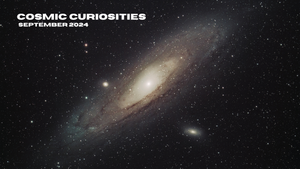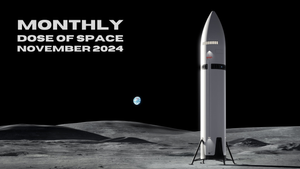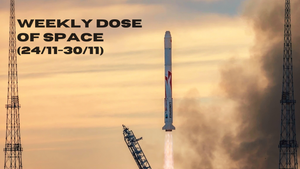
Cosmic Curiosities - September 2024
Hello and welcome to the second "Cosmic Curiosities" newsletter! In this monthly newsletter, we will go over the big astronomy events you should expect in the coming month. From meteor showers to planetary aligning and anything in between. We also will dive into all of the out-of-this-world discoveries and big stories from the past month!
What's up this month?
September is packed with space events making it a perfect month for both amateur stargazers and professional astrophotographers. Let's quickly dive into all the major celestial events happening in September!
New Moon - September 3rd

Kicking off the month, the Moon will hit its "New Moon" phase on the 3rd. A new Moon occurs when the Moon is directly between the Earth and the Sun, making the Moon nearly impossible for the unaided eye to see. New Moons occur about once a month because that is nearly how long the lunar cycle is. As the days count down, the Moon will only be apparent in the night sky by thin lighting seen on the edges of our celestial neighbor. As we get closer to the third, this crescent of light will dim. If you are lucky to have clear skies at the beginning of September, definitely look up at the night sky, as the Moon's light won't interfere with the fainter stars, making stargazing a lot more enjoyable!
Saturn opposition - September 8th

Less than a week after the Moon restarts its lunar cycle, Saturn will be at opposition, making it the brightest it will be this year. Opposition refers to when Saturn is "opposite" of the Sun. Earth will fall in between the ringed gas giant and our host star, meaning Saturn's plane will be completely illuminated from our perspective. Soon after sunset on Sunday the 8th, be sure to look towards the East and you'll be sure to see Saturn, that is if local weather cooperates.
You will easily be able to see Saturn (as a bright light in the night sky) with the naked eye, however, if you have the ability, using a telescope or binoculars will enhance the experience even more as you should be able to see the gas giants rings!
Partial Lunar Eclipse - September 17th

As you may (or may not) know, a lunar eclipse occurs when the Moon goes behind the Earth. Meaning the Earth is "in-between" the Moon and the Sun. However, a partial lunar eclipse is when only part of the Moon is covered by the Earth's umbral shadow, while the other part is lit as normal. This is caused when the celestial objects aren't exactly aligned; Making part of the Moon appear red and far dimmer, while the rest will be lit up by the glaring sun.
Below you can see where the partial lunar eclipse will be best seen on Earth as well as the best times to view the eclipse, based on a few cities.

Super Harvest Moon - September 18th

A day after the partial lunar eclipse, the Moon will enter its "super harvest" phase. A harvest Moon is the name given to the full Moon that falls closest to the autumnal equinox. The name was given to the Moon as before electricity farmers used the light of the Moon to help them harvest crops into the later parts of the evening. Though, it doesn't stop there as this is also a super Moon, making Wednesday's Moon a "Super Harvest Moon." A "super" Moon is the name given to our cosmic neighbor when it is both at its fullest luminosity and its closest to Earth (at its orbital perigee).
September Equinox - September 22nd

Closing out the month we have the September equinox, marking the beginning of Autumn! An equinox is when the Sun appears directly above the equator, rather than just north or south of it. Because of this, the sunlight is nearly completely uniform on the surface of the Earth, making night and day approximately equal in length. Once the equinox is done those in the north can expect the days to get shorter and shorter, while the nights get longer and longer; the opposite will occur in the southern hemisphere.
Interstellar news from August
Now let's dive into the biggest news stories in our solar system and beyond from the past month!
NASA's Roman Grace Telescope aims to investigate galactic fossils

Set to launch in 2027, NASA's upcoming Roman-Grace telescope will boast a field of view 100 times larger than that of Hubble and will probe the Universe in infrared. Far part of its scientific observation, astronomers will use the telescope to study galactic "fossils" helping scientists understand how galaxies form and evolve. Studying galactic fossils is very hard, as most galaxies we observe are already (or nearly) fully evolved. There are small instances where scientists have been able to piece together the evolution of galaxies based on small factors. One of these small factors is looking at the stellar structure within a galaxy. The structure of galaxies, as you know, is made up of stars. Thus, if you study the stars closely, scientists can piece together the evolution of galaxies. Astronomers are now setting up potential observations under the name RINGS (Roman Infrared Nearby Galaxies Survey). Under this, Roman will study ancient stars that can hint at a galaxy's evolution as well as the chemical makeup of the ever-changing galaxy. It isn't known yet if this will be added to the orbital observatories science roster, but let's hope it is!
NASA's Roman telescope and Hubble will likely team up to better study key targets. Roman's vast wide field view is a great complimentary aide to Hubble's more narrow view.
Event Horizon Telescope gets performance boost

The Atacama Large Millimeter/submillimeter Array (ALMA) and Event Horizon Telescope (EHT) teamed up recently, obtaining the highest resolution ever observed from the surface of the Earth. The two telescope clusters were able to detect light from the center of distance galaxies at a frequency of 345 GHz (equivalent to a wavelength of 0.87mm). Astronomers estimate that breakthroughs with this growing collaborative effort will make black hole images 50% more detailed than previously possible. This increased capability will allow astronomers the ability to further study the area immediately around these cosmic titans.
Fun fact: EHT and ALMA have paired up in the past to image the first black hole ever at the center of the M87 galaxy back in 2019 and later the Sagittarius A black hole at the center of our very own, Milky Way galaxy.
Perseverance begins a hike up the Jezero crater

After spending three and a half years exploring the floor of the Jezero crater, NASA's Perseverance rover embarked on a hike up to the crater rim on August 19th. This slow hike will take over a month to be completed and marks a new leg of the robotic surveyor's scientific mission. Once the rover safely ascends the nearly 300-meter (1,000ft) wall of the crater, it will begin to conduct science on the crater rim. Two points of interest have been set up in advance, one named "Pico Turquino” and the other “Witch Hazel Hill." Based on imagery collected by various NASA Mars orbiters, planetary scientists believe that the two sites have geological signs (in the form of fractures) that could very easily have been caused by ancient hydrothermal activity on the red planet.
Our samples are already an incredibly scientifically compelling collection, but the crater rim promises to provide even more samples that will have significant implications for our understanding of Martian geologic history” - Eleni Ravanis, Scientist and one of the Crater Rim Campaign science leads.
Celestial Spotlight
Finally, lets go over the space image of the month captured by NASA's Hubble space telescope!

Hubble probes Andromeda's rosy tendrils
NASA's Hubble Space Telescope (HST) took this truly breathtaking image of the Milky Way's galactic neighbor, Andromeda. Andromeda, also known as M31 is a galaxy located some 2.5 million light years away from our own. This stood out to the team here as a breathtaking and fascinating image. I mean think about it, we are looking at hundreds of thousands of stars OUTSIDE of our galaxy. All with likely a handful of planets each, worlds as unaware of our existence, as we are unaware of theirs.
Using Hubble's Advanced Camera for Surveys (ACS) and Wide Field Camera 3 (WFC3), astronomers were able to zoom into the spiral arms of our galactic counterparts. The red gas you see is a clear indicator of recent (at a universal scale) star-forming activities. The study of these tendrils has given scientists a large sample size of stars, furthering our understanding of the galaxy's stellar diversity and history, as well as more insight into stellar formation and evolution. Due to Andromeda's scale in our night sky and relative proximity to our galaxy, it is the perfect night sky object for astronomers, professional or amateur to further explore the mysteries of the universe. Studying Andromeda allows scientists around the world the ability to better understand our galaxy as well as how galaxies billions of light years away operate, so to speak.
Honorable Mention
As promised last time, we want to slowly expand upon this portion of the newsletters, so here is an honorable mention for this month's Celestial spotlight!

Cosmic sea, home and the ISS
Taken by Astronaut Matthew Dominick while aboard the International Space Station, this is truly an amazing image and could easily be this month's celestial spotlight. Matthew always delivers when it comes to capturing the beauty of the universe from aboard the ISS, showcasing the Milky Way in ways we never have seen before! The atmosphere being illuminated by the Sun and the slight aurora effect due to particles being charged in the upper atmosphere is the icing on the cake in this image. It reminds us of the famous Sagan quote that goes as follows:
We have lingered long enough on the shores of the cosmic ocean, we are ready at last to set sail for the stars." - Carl Sagan, Cosmos
That is all from us today, we hope you enjoy the second edition of Cosmic Curiosities, we plan on continually refining and improving this newsletter, so stay tuned! Until next time, happy star-watching!




